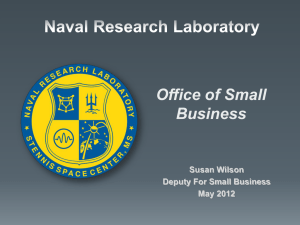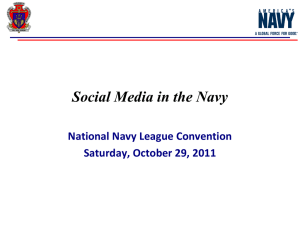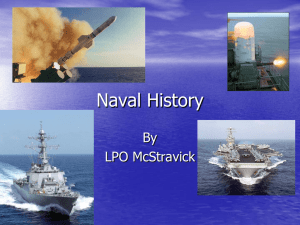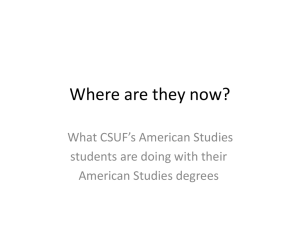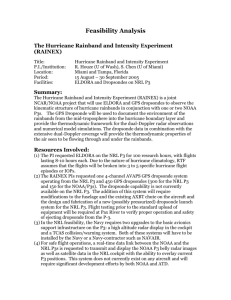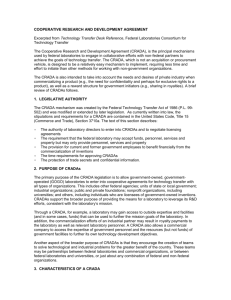NRL Technology Transfer Office
advertisement
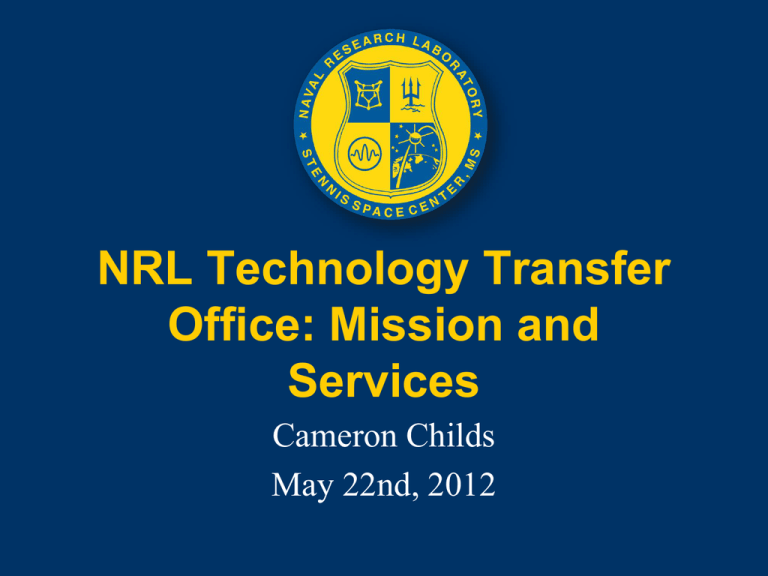
NRL Technology Transfer Office: Mission and Services Cameron Childs May 22nd, 2012 Why Have a Tech Transfer Office? • Stevenson-Wydler Technology Innovation Act of 1980 – Office of Research and Technology Applications (ORTA) required • Leveraging of the facility’s R&D dollars • Lower-cost, readily-available goods to the Fed Govt. • US job creation • Increase Navy facility name recognition and publicity • Royalty income stream (to inventors and to facility) • Inventor rewards – monetary and intangible The Navy and Marine Corps Corporate Laboratory NRL’s Technology Transition and Technology Transfer “Technology Transition” : transition from research to the field (military applications) • Reports • Web postings • Government Purpose Licenses to fulfill a specific government contract • Publications “Technology Transfer”: collaborate to generate new intellectual property (IP) or transfer IP to a commercial partner • • • • • Proprietary Discussions (Confidentiality) Material Transfers Collaborations (CRADAs, Sabbaticals, Visiting Scientists) Patent licenses Publications The Navy and Marine Corps Corporate Laboratory NRL’s Tech Transfer Office Mission It is the mission of the Technology Transfer Office to facilitate the implementation of NRL's innovative technologies in products and services to benefit the public. This includes contractually protecting NRL’s IP and tracking IP obligations. Primary “Get the technology out there….” Secondary “If you can bring in a lot of money also, that’s great …” The Navy and Marine Corps Corporate Laboratory How Does a Tech Transfer Office Fulfill Its Obligations? The Tech Transfer Office manages all contractual obligations to IP in order to assure NRL has clear legal standing to license it technologies. • Protects against disclosure of NRL proprietary information (information not patented or previously published) NDA • Protects against selling or reverse engineering NRL materials. MTA • Protects against unauthorized distribution or modification of NRL software. STA • Negotiates Agreements between joint owners of IP (IAA) • Negotiates collaborative agreements. CRADA • Negotiates Sabbatical Agreements; Visiting Scientist Agreements • Negotiates licenses (PLA and GPL) The Navy and Marine Corps Corporate Laboratory Primary Mechanisms for Tech Transfer • Non Disclosure Agreements • Material Transfer Agreements • Co-operative Research and Development Agreements (CRADAs) • Patent Licenses (least transfer to most) The Navy and Marine Corps Corporate Laboratory NDAs and MTAs Non-Disclosure Agreement A collaboration is anticipated and: – Proprietary information is to be exchanged, and/or – The other party wants NRL software and/or material. Material Transfer Agreement No collaboration is anticipated and: – Material will be transferred; investigator would like the results of what happens to the material (testing, processing etc.) The Navy and Marine Corps Corporate Laboratory CRADAs • Between NRL and one or more non-Federal parties to collaborate on mutually beneficial R&D in any area that is consistent with NRL’s mission. • NRL may provide personnel, services, facilities, and equipment to the joint R&D effort but no funds to the other party. • The non-Federal party may provide funds, in addition to personnel, services, facilities, and equipment to the joint R&D effort. • Not subject to FAR (Federal Acquisition Regulations) – advertisement not required; can choose CRADA partner The Navy and Marine Corps Corporate Laboratory CRADAs • IP Rights – Subject Inventions under a CRADA (jointly or solely developed): • Government retains right to use for Government purposes. • Collaborator retains free non-exclusive license for internal use, and option for fee-bearing commercial license. • Personnel performing substantial work on a CRADA on behalf of NRL must be NRL employees (not contractors) – Rights to Background Inventions not included and may need to be licensed for CRADA partner’s commercial endeavors • Best effort basis (mission comes first) • Often executed prior to a license for evaluation purposes. • CRADAs with foreign entities require special approvals and may require an export license. The Navy and Marine Corps Corporate Laboratory Licenses • Navy can license issued patents, patent applications, “patentable inventions”, trademarks • Licenses can be Non-Exclusive (NX), PartiallyExclusive (PX), Exclusive (EX) – Partially exclusive = exclusive in a field of use – Intent to Grant notice in Federal Register required for PX or EX licenses – Application for License required, including Business Plan, Date of Practical Application, Sales Forecast – “Substantially manufacture in the US” required • Government Purpose Licenses - right to manufacture and sell to US Government only in the performance of a Government Contract. The Navy and Marine Corps Corporate Laboratory Licenses • Typical License Financial Terms: – Upfront fee, typically paid upon execution but installment payments are possible • Cash (preferred) • Deferred compensation (“phantom stock”) – Milestone payments – lump sums tied to achievements – Running Royalty, paid annually – Minimum annual royalties, paid in advance – Out-of-pocket patent expenses reimbursement required (foreign filing; other fees) • Other Terms – Diligence (required milestones) – Field of Use – Territory The Navy and Marine Corps Corporate Laboratory Other Agreements • Memorandum of Understanding (MOU) - Use only with other Government agencies; not legally binding; general agreement of intent • Memorandum of Agreement (MOA) - Use only with other Government agencies; not legally binding; firm agreement for action • Agreement to Provide Goods and Services (WFOPA) – use when … – No collaboration anticipated – NRL performs work on contractor’s problem – Leasing unique, excess capacity facilities or performing services not available commercially – No IP rights at issue The Navy and Marine Corps Corporate Laboratory Researcher’s Role • Create the Intellectual Property – Patents (Including Patentable Software) • NRL currently has ~700 issued patents and 400 nonprovisional patent applications available for licensing – Trademarks • Assist the Tech Transfer Office in Marketing – Alert TTO of potential commercial uses and companies that express interest (contacts at scientific meetings) • Participate in CRADAs if appropriate The Navy and Marine Corps Corporate Laboratory Royalty Sharing Example $15,000 $5K Patent A $5K Patent B $5K Patent C Inventors $1666.67 each $2000 + $600 $2000 + $100 $3766.67 Assumes the first $2K has not already been received from another payment on that invention in the current fiscal year. Cap at $150,000/yr. The Navy and Marine Corps Corporate Laboratory How We Market the Technology • Inventor is usually the primary source of leads • TTO targeted marketing • NRL tech transfer website: http://techtransfer.nrl.navy.mil • DoD TechMatch website: http://www.dodtechmatch.com • Partnership Intermediaries – TechLink/ Springboard The Navy and Marine Corps Corporate Laboratory Contact Info and Q&A • Contact Info: – Rita Manak, Head, Technology Transfer Office (202) 767 3083 Rita.manak@nrl.navy.mil – http://www.nrl.navy.mil/techtransfer The Navy and Marine Corps Corporate Laboratory

